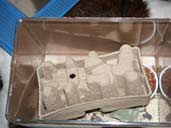Dubia Roaches
 |
 |
 |
 |
Name: Dubia Roach, but sometimes referred to as the Argentine Roach, the Orange Spotted Roach or the Guyana Spotted Roach.
Scientific name: Blaptica dubia
Lifespan: 9-10 months for males, but females live longer, usually reaching 18 – 20 months.
Benefits as a food
Dubia Roaches are easy to digest and make a very meaty and nutrious meal. The various life stages of the roach will offer a wide variety of prey size to offer your amphibians, with nymphs being suitable for smaller amphibians and adults being suitable for larger specimens.
Dubia Roaches are easy to keep, cheap to feed, long-lived and silent within the home, which makes them a good, affordable choice to have as a handy food item.
Housing
 Dubia Roaches should be housed in a ventilated plastic tub, preferably with a large surface area. Dubia Roaches do not climb well on smooth surfaces, so ensure that the sides of the tub are not textured. A RUB (really useful box), sandwich tub or old plastic biscuit tin are all fine. Air holes should be punched into the lid of the box for ventilation or alternatively cut a large section of the lid out with some sharp scissors and cover the hole with a fine mesh or a recycled pair of old tights (pantyhose). No substrate needs to be used, so this makes cleaning a more simple process.
Dubia Roaches should be housed in a ventilated plastic tub, preferably with a large surface area. Dubia Roaches do not climb well on smooth surfaces, so ensure that the sides of the tub are not textured. A RUB (really useful box), sandwich tub or old plastic biscuit tin are all fine. Air holes should be punched into the lid of the box for ventilation or alternatively cut a large section of the lid out with some sharp scissors and cover the hole with a fine mesh or a recycled pair of old tights (pantyhose). No substrate needs to be used, so this makes cleaning a more simple process.
Dubia Roaches prefer the dark, so keeping them in a dark place is recommended. They will also require places to hide, so cardboard tubes or egg box bottoms placed in the tub will help them to feel secure.
Feeding
 Dubia Roaches are scavengers by nature, so will eat almost anything, but as you are going to be feeding them to your amphibians it is wise to feed them on foods that boost their nutritional value. Dry foods like oats, bran, dried dog/cat food and flaked fish food should always be readily available, but the addition of plenty of fresh vegetables regularly would give the feeder roaches a good diet. Variety is recommended, but potatoes and carrots are a favourite as well as fruits like banana and apple. All the food items should be chopped into small pieces to make them easier to consume by the roaches.
Dubia Roaches are scavengers by nature, so will eat almost anything, but as you are going to be feeding them to your amphibians it is wise to feed them on foods that boost their nutritional value. Dry foods like oats, bran, dried dog/cat food and flaked fish food should always be readily available, but the addition of plenty of fresh vegetables regularly would give the feeder roaches a good diet. Variety is recommended, but potatoes and carrots are a favourite as well as fruits like banana and apple. All the food items should be chopped into small pieces to make them easier to consume by the roaches.
There is no need to add water to the container, as they should be able to source all their water from their food, but if you do prefer to give them something to drink just add a damp sponge or slightly soaked cotton wool to avoid the roaches drowning in a water bowl.
Temperature
Dubia Roaches should be kept at an optimum temperature of around 27°C (81°F). They can survive at lower temperatures, but will not breed as quickly at temperatures below this.
Breeding
 Dubia Roaches become sexually mature at 6 months of age, so setting up a successful breeding colony is not a drawn out process time wise. Once mature, females will lay between 25-35 eggs every two months, so it is advised to keep your females for as long as possible and use them as prey items more sparingly than the males.
Dubia Roaches become sexually mature at 6 months of age, so setting up a successful breeding colony is not a drawn out process time wise. Once mature, females will lay between 25-35 eggs every two months, so it is advised to keep your females for as long as possible and use them as prey items more sparingly than the males.
Adult Dubia roaches are easy to sex as the females are larger than the males and only have buds, whereas males develop full wings. Unfortunately sexing nymphs is quite difficult as they only look dissimilar as they mature.
Other Useful Information
Many amphibian keepers are often reluctant to start a feeder roach colony for fear of escapees causing an infestation in the house, but Dubia Roaches are a tropical species so need high temperatures and humidity to breed. This means that if any of your colony do escape, they will not be able to infest your home, because the conditions will not be right to facilitate breeding.
